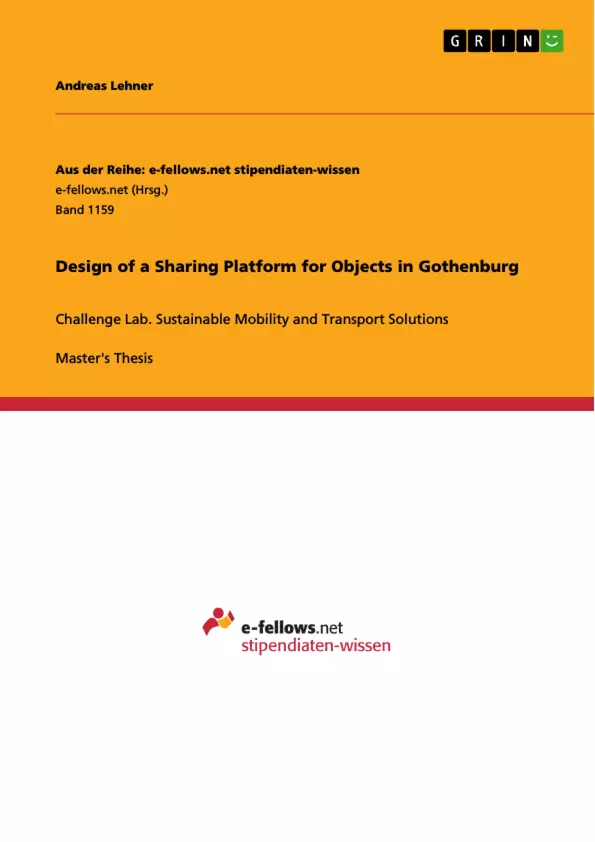This thesis consists of two parts. Part I describes the Challenge Lab method, which is a method developed at Chalmers for students to utilize their creativity to come up with innovative solutions for a change towards a more sustainable society. The Challenge Lab was carried out between January and June 2014 by 12 graduate students from seven countries. It used several tools, perspectives, theories and frameworks that should enable the students to act as change agents between academia, public and private sector by introducing solutions for a sustainable transport system. Amongst other methods, the Challenge Lab included dialogue tools, value and leadership workshops, design thinking and backcasting.
In Part II of this thesis, a system to reduce the environmental impact of each individual, called a sharing economy, is described and a convenient and accessible technological solution to implement in the public space is illustrated.
Through practical methods such as workshops and participation in the Gothenburg Startup Hack a prototype of a smart box was developed. This system could provide a convenient and accessible solution by offering a service similar to public lockers, which can be opened by using a web service and would be at accessible places in public spaces (bus stops, etc.). During the process a possible partnership with a project in Gothenburg, called “ElectriCity”, was identified and could be developed further on after the end of this thesis.
The main barrier of the sharing economy for reaching a mass-market was found to be trust amongst the individuals using the sharing platform. Several possible solutions to provide a trust-worthy service were identified and will be presented in the thesis. These include, amongst others, an insurance pool and a review system.
Inhaltsverzeichnis (Table of Contents)
- Abstract
- Acknowledgements
- Part I: The Challenge Lab
- 1. Introduction
- 1.1. Background
- 1.2. Purpose
- 1.3. Research Questions
- 1.4. Method
- 1.5. The Challenge Lab Process
- 1.6. Deliverables
- 1.7. The Student Team
- 2. Theory and Framework
- 2.1. Introduction
- 2.2. Innovation and Technology
- 2.3. The Challenge Lab Method
- 2.4. Sustainability and Technology
- 2.5. Systemic Change
- 2.6. Stakeholders
- 2.7. Backcasting
- 2.8. Systems Thinking
- 2.9. Design Thinking
- 2.10. Dialogue Tools
- 2.11. Value and Leadership Workshops
- 2.12. Discussion
- 3. Results
- 3.1. Results from the Challenge Lab process
- 3.2. The Future of Mobility in Gothenburg
- 3.3. The ElectriCity Project
- 3.4. The Gothenburg Startup Hack
- 3.5. The Prototype
- 3.6. Challenges
- 3.7. Solutions
- 3.8. Discussion
- 4. Conclusions
- Part II: Sharing Economy
- 5. Introduction
- 5.1. Background
- 5.2. Purpose
- 5.3. Research Questions
- 5.4. Method
- 5.5. Deliverables
- 6. Theory and Framework
- 6.1. Introduction
- 6.2. The Sharing Economy
- 6.3. Technological Solutions
- 6.4. Stakeholders
- 6.5. Business Models
- 6.6. Discussion
- 7. Results
- 7.1. Results from the Gothenburg Startup Hack
- 7.2. Trust as a Barrier
- 7.3. Possible Solutions
- 7.4. Discussion
- 8. Conclusions
- References
Zielsetzung und Themenschwerpunkte (Objectives and Key Themes)
This master’s thesis focuses on developing a sharing platform for objects in Gothenburg, Sweden. It explores the potential of the sharing economy as a means to reduce environmental impact and promote sustainable mobility. The thesis utilizes the Challenge Lab method, a framework for fostering innovation and collaboration among students, to address the challenges and opportunities of implementing a sharing platform in the public space.
- The Challenge Lab method and its application to sustainable mobility
- The concept of the sharing economy and its potential for environmental sustainability
- The development of a technological solution for facilitating object sharing in the public space
- Addressing the challenges of trust and security in the context of a sharing platform
- Identifying potential partnerships and stakeholders for implementing the sharing platform in Gothenburg
Zusammenfassung der Kapitel (Chapter Summaries)
- Part I: The Challenge Lab
- Chapter 1: Introduction Introduces the Challenge Lab method, its purpose, research questions, and the student team involved in the project. It outlines the project's objective of developing innovative solutions for a more sustainable society.
- Chapter 2: Theory and Framework Presents a theoretical framework for the Challenge Lab, encompassing concepts like innovation, technology, sustainability, and systemic change. It also examines various methods employed, including design thinking, backcasting, and dialogue tools.
- Chapter 3: Results Details the outcomes of the Challenge Lab process, including the identification of future mobility trends in Gothenburg, the ElectriCity project, and the development of a prototype for a smart box sharing platform.
- Part II: Sharing Economy
- Chapter 5: Introduction Presents the concept of the sharing economy and its potential for reducing environmental impact. It defines the research questions and methods used to explore the implementation of a sharing platform in Gothenburg.
- Chapter 6: Theory and Framework Explores the theoretical underpinnings of the sharing economy, including technological solutions, stakeholder engagement, and business model considerations.
- Chapter 7: Results Highlights the findings from the Gothenburg Startup Hack event, specifically focusing on the challenges of trust and security in the context of object sharing. It also presents potential solutions to these challenges.
Schlüsselwörter (Keywords)
This thesis explores the intersection of sustainable mobility, the sharing economy, and technological innovation. The focus is on the development of a sharing platform for objects in Gothenburg, utilizing the Challenge Lab method to foster collaboration and creative solutions. The key concepts include the sharing economy, trust, security, technological solutions, stakeholder engagement, and the ElectriCity project in Gothenburg.
- Arbeit zitieren
- Andreas Lehner (Autor:in), 2014, Design of a Sharing Platform for Objects in Gothenburg, München, GRIN Verlag, https://www.grin.com/document/294914



